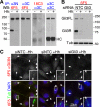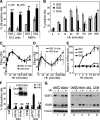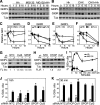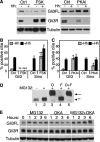Kinetics of hedgehog-dependent full-length Gli3 accumulation in primary cilia and subsequent degradation
- PMID: 20154143
- PMCID: PMC2849461
- DOI: 10.1128/MCB.01089-09
Kinetics of hedgehog-dependent full-length Gli3 accumulation in primary cilia and subsequent degradation
Abstract
Hedgehog (Hh) signaling in vertebrates depends on intraflagellar transport (IFT) within primary cilia. The Hh receptor Patched is found in cilia in the absence of Hh and is replaced by the signal transducer Smoothened within an hour of Hh stimulation. By generating antibodies capable of detecting endogenous pathway transcription factors Gli2 and Gli3, we monitored their kinetics of accumulation in cilia upon Hh stimulation. Localization occurs within minutes of Hh addition, making it the fastest reported readout of pathway activity, which permits more precise temporal and spatial localization of Hh signaling events. We show that the species of Gli3 that accumulates at cilium tips is full-length and likely not protein kinase A phosphorylated. We also confirmed that phosphorylation and betaTrCP/Cul1 are required for endogenous Gli3 processing and that this is inhibited by Hh. Surprisingly, however, Hh-dependent inhibition of processing does not lead to accumulation of full-length Gli3, but instead renders it labile, leading to its proteasomal degradation via the SPOP/Cul3 complex. In fact, full-length Gli3 disappears with faster kinetics than the Gli3 repressor, the latter not requiring SPOP/Cul3 or betaTrCP/Cul1. This may contribute to the increased Gli3 activator/repressor ratios found in IFT mutants.
Figures







Similar articles
-
Cilium-independent regulation of Gli protein function by Sufu in Hedgehog signaling is evolutionarily conserved.Genes Dev. 2009 Aug 15;23(16):1910-28. doi: 10.1101/gad.1794109. Genes Dev. 2009. PMID: 19684112 Free PMC article.
-
PKA-mediated Gli2 and Gli3 phosphorylation is inhibited by Hedgehog signaling in cilia and reduced in Talpid3 mutant.Dev Biol. 2017 Sep 1;429(1):147-157. doi: 10.1016/j.ydbio.2017.06.035. Epub 2017 Jul 1. Dev Biol. 2017. PMID: 28673820 Free PMC article.
-
The Orphan G Protein-coupled Receptor Gpr175 (Tpra40) Enhances Hedgehog Signaling by Modulating cAMP Levels.J Biol Chem. 2015 Dec 4;290(49):29663-75. doi: 10.1074/jbc.M115.665810. Epub 2015 Oct 8. J Biol Chem. 2015. PMID: 26451044 Free PMC article.
-
Regulatory mechanisms governing GLI proteins in hedgehog signaling.Anat Sci Int. 2025 Mar;100(2):143-154. doi: 10.1007/s12565-024-00814-1. Epub 2024 Nov 22. Anat Sci Int. 2025. PMID: 39576500 Review.
-
Hedgehog signaling pathway: a novel model and molecular mechanisms of signal transduction.Cell Mol Life Sci. 2016 Apr;73(7):1317-32. doi: 10.1007/s00018-015-2127-4. Epub 2016 Jan 13. Cell Mol Life Sci. 2016. PMID: 26762301 Free PMC article. Review.
Cited by
-
Cell signaling and transcriptional regulation of osteoblast lineage commitment, differentiation, bone formation, and homeostasis.Cell Discov. 2024 Jul 2;10(1):71. doi: 10.1038/s41421-024-00689-6. Cell Discov. 2024. PMID: 38956429 Free PMC article. Review.
-
Rer1p maintains ciliary length and signaling by regulating γ-secretase activity and Foxj1a levels.J Cell Biol. 2013 Mar 18;200(6):709-20. doi: 10.1083/jcb.201208175. Epub 2013 Mar 11. J Cell Biol. 2013. PMID: 23479743 Free PMC article.
-
Proteostasis in the Hedgehog signaling pathway.Semin Cell Dev Biol. 2019 Sep;93:153-163. doi: 10.1016/j.semcdb.2018.10.009. Epub 2018 Nov 14. Semin Cell Dev Biol. 2019. PMID: 31429406 Free PMC article. Review.
-
The formation of the thumb requires direct modulation of Gli3 transcription by Hoxa13.Proc Natl Acad Sci U S A. 2020 Jan 14;117(2):1090-1096. doi: 10.1073/pnas.1919470117. Epub 2020 Jan 2. Proc Natl Acad Sci U S A. 2020. PMID: 31896583 Free PMC article.
-
Protein kinase inhibitor SU6668 attenuates positive regulation of Gli proteins in cancer and multipotent progenitor cells.Biochim Biophys Acta. 2014 Apr;1843(4):703-14. doi: 10.1016/j.bbamcr.2014.01.003. Epub 2014 Jan 10. Biochim Biophys Acta. 2014. PMID: 24418624 Free PMC article.
References
-
- Agren, M., P. Kogerman, M. I. Kleman, M. Wessling, and R. Toftgard. 2004. Expression of the PTCH1 tumor suppressor gene is regulated by alternative promoters and a single functional Gli-binding site. Gene 330:101-114. - PubMed
-
- Alexandre, C., A. Jacinto, and P. W. Ingham. 1996. Transcriptional activation of Hedgehog target genes in Drosophila is mediated directly by the cubitus interruptus protein, a member of the GLI family of zinc finger DNA-binding proteins. Genes Dev. 10:2003-2013. - PubMed
-
- Aza-Blanc, P., H. Y. Lin, A. Ruiz i Altaba, and T. B. Kornberg. 2000. Expression of the vertebrate Gli proteins in Drosophila reveals a distribution of activator and repressor activities. Development 127:4293-4301. - PubMed
-
- Aza-Blanc, P., F. A. Ramirez-Weber, M. P. Laget, C. Schwartz, and T. B. Kornberg. 1997. Proteolysis that is inhibited by Hedgehog targets Cubitus interruptus protein to the nucleus and converts it to a repressor. Cell 89:1043-1053. - PubMed
MeSH terms
Substances
LinkOut - more resources
Full Text Sources
Other Literature Sources
Molecular Biology Databases
